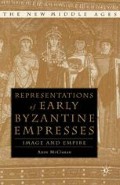Abstract
The medieval textual record of the Empress Theodora voices many perspectives, yet the work of the sixth-century historian Prokopios overwhelms our contemporary image of her, as the quote by Gibbon illustrates. Prokopios wrote an account of Justinianic building and military history, but his most widely read work is the so-called Secret History, the Anekdota in Greek. Even its tantalizing modern name, the Secret History, bespeaks the special status of this text, which now must be balanced against a fuller consideration of other sources for the period.
Her murmurs, her pleasures, and her arts must be veiled in the obscurity of a learned language….
— Edward Gibbon, The Decline and Fall of the Roman Empire, ed. J. B. Bury, vol. 4 (London: Methuen, 1909), p. 228.
Access this chapter
Tax calculation will be finalised at checkout
Purchases are for personal use only
Preview
Unable to display preview. Download preview PDF.
Notes
J. A. S. Evans, The Age of Justinian: The circumstances of imperial power (New York: Routledge, 1996), p. 4.
Hans-Georg Beck, Kaiserin Theodora and Prokop (Munich: Piper, 1986), p. 93.
Averil Cameron, Procopius and the Sixth Century (Berkeley: University of California Press, 1985), p. 50.
Charles Diehl, Théodora: Impératrice de Byzance (Paris: Eugène Rey, 1904), pp. 289–304.
Henry Maguire, Art and Eloquence in Byzantium (Princeton: Princeton University Press, 1981), p. 13.
Hans-Georg Beck, Kaiserin Theodora and Prokop (Munich: Piper, 1986), p. 18.
Stanley Fish, “How to Recognize a Poem When You See One,” Is There a Text in This Class? (Cambridge, MA: Harvard University Press, 1980), pp. 322–37.
John W. Barker, Justinian and the Later Roman Empire (Madison, WI: University of Wisconsin Press, 1966), p. 68.
Lynda Garland several times nods at the tradition of invective, but she does not to a large degree does not take the Anekdota’s rhetorical structure into account in evaluating its assertions. Lynda Garland, Byzantine Empresses: Women and Power in Byzantium A.D. 527–1204 (London: Routledge, 1999), p. 15.
Lynda Garland, “‘The Eye of the Beholder’: Byzantine Imperial Women and their Public Image from Zoe Porphyrogenita to Euphrosyne Kamaterissa Doukaina (1028–1203),” Byzantion 64 (1994): 31 [19–39].
Peggy McCracken, The Romance of Adultery: Queenship and Sexual Transgression in Old French Literature (Philadelphia: University of Pennsylvania Press, 1998), p. 30.
Mikhail Bakhtin, Rabelais and His World, trans. Hélène Iswolsky (Bloomington: Indiana University Press, 1984), p. 370.
Pauline Allen, “Contemporary Portrayals of the Byzantine Empress Theodora (AD 527–548),” in Stereotypes of Women in Power: Historical Perspectives and Revisionist Views, ed. Barbara Garlick, Suzanne Dixon, and Pauline Allen (New York: Greenwood Press, 1992), p. 96.
Lynn Hunt, “The Many Bodies of Marie Antoinette: Political Pornography and the Problem of the Feminine in the French Revolution,” in Eroticism and the Body Politic (Baltimore: Johns Hopkins University Press, 1991), p. 111.
Sherry Ortner, “The Virgin and the State,” Feminist Studies 4.3 (1978): 31 [19–36].
Janet Fairweather, “Fiction in the Biographies of Ancient Writers,” Ancient Society 5 (1974): 237 [231–75].
Form rather than content dictated genre in this milieu. Holt Parker, “Love’s Body Anatomized: The Ancient Erotic Handbooks and the Rhetoric of Sexuality,” in Pornography and Representation in Greece and Rome, ed. Amy Richlin (New York: Oxford University Press, 1992), p. 91 [90–111].
Elizabeth A. Fisher, “Thedora and Antonina in the Historia Arcana: History and/or Fiction?” in Women in the Ancient World:The Arethusa Papers, ed. John Peradotto and J. P Sullivan (Albany: State University of New York Press, 1984), p. 310 [287–313].
Michel Foucault, The History of Sexuality, 3 vols., trans. Robert Hurley (New York: Random House, 1978), 1:35.
Averil Cameron, “Gibbon and Justinian,” in Edward Gibbon and Empire, ed. Rosamond McKitterick and Roland Quinault (New York: Cambridge University Press, 1997), p. 38 [34–52].
Gustave Flaubert, The Dictionary of Received Ideas, trans. Geoffrey Wall (New York: Penguin, 1994), p. 21.
Bram Dijkstra, Idols of Perversity: Fantasies of Feminine Evil in Fin-de-Siècle Culture (New York: Oxford University Press, 1986), p. 387. This is a longstanding stereotype noted by art historians as well, “The so-called Oriental woman has often been conflated with the erotic in the European imagination”
Anna C. Chave, “New Encounters with Les Demoiselles d’Avignon: Gender, Race, and the Origins of Cubism,” Art Bulletin 76 (1994): 600 [596–611].
Paul I. Wellman, The Female:A Novel of Another Time (New York: Doubleday, 1953);
John W. Vandercook, Empress of the Dusk: a life of Theodora of Byzantium (New York: Reynal and Hitchcock, ca. 1940);
Gillian Bradshaw, The Bearkeeper’s Daughter (Boston: Houghton Mifflin, 1987).
Liz James notes that in these novels “sex is ever present but prurient.” Liz James, — As the actress said to the bishop… ‘: the portrayal of Byzantine women in English-language fiction,” in Through the Looking Glass: Byzantium Through British Eyes, ed. Robin Cormack and Elizabeth Jeffreys (Burlington: Ashgate, 2000), p. 244 [237–50].
Copyright information
© 2002 Anne McClanan
About this chapter
Cite this chapter
McClanan, A. (2002). Looking at Her: Prokopios Rhetor and the Representation of Empress Theodora. In: Representations of Early Byzantine Empresses. The New Middle Ages. Palgrave Macmillan, New York. https://doi.org/10.1007/978-1-137-04469-3_6
Download citation
DOI: https://doi.org/10.1007/978-1-137-04469-3_6
Publisher Name: Palgrave Macmillan, New York
Print ISBN: 978-1-349-63536-8
Online ISBN: 978-1-137-04469-3
eBook Packages: Palgrave History CollectionHistory (R0)

